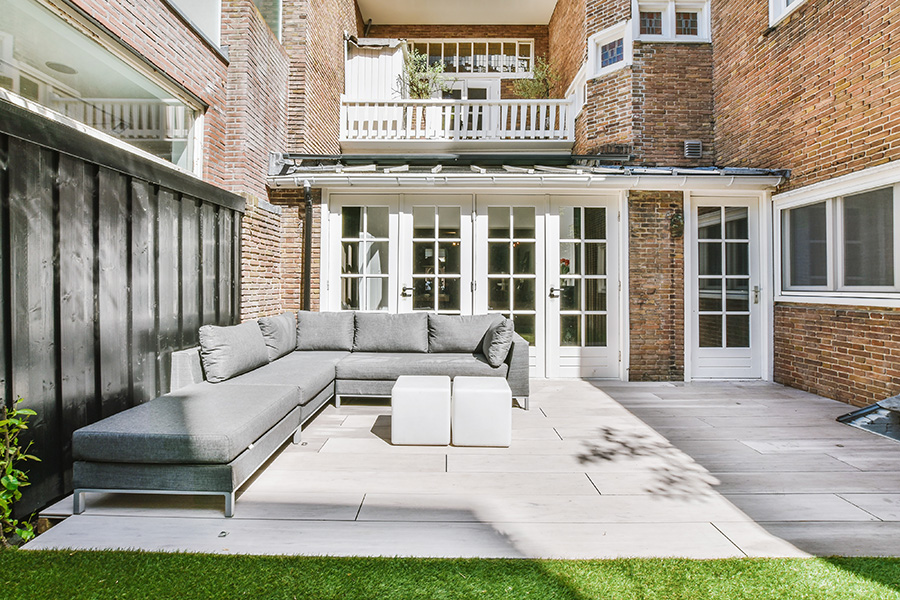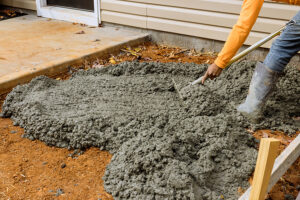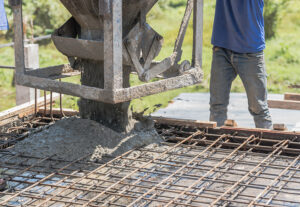Table of Contents
Hey there, homeowners! Are you considering adding a concrete patio to your outdoor space?
Well, before you dive into the exciting world of patio designs and finishes, there’s an important factor you should consider first: the thickness of your concrete.
While it may seem like a small detail, it holds great importance regarding the durability and longevity of your patio.
You don’t want to end up with a cracked or uneven surface that needs constant repairs, do you?
That’s why, in this blog post, we will guide you through determining the appropriate thickness for your concrete patio.
So, if you want your patio to withstand the test of time and provide you with endless outdoor enjoyment, keep reading!
We’ll also share some insights from research and provide you with a range of recommended thicknesses to ensure you make the best decision for your home.
Factors Influencing Concrete Patio Thickness
Purpose of the patio
When it comes to designing a concrete patio, determining the appropriate thickness is an important consideration for ensuring its durability and longevity.
Several factors influence the ideal thickness of a concrete patio, including the purpose of the patio and the expected level of use.
Let’s explore the factors that determine the recommended thickness:
Light Use:
A concrete patio designed for light use typically serves as a leisure area or a garden pathway.
In such cases, a thinner concrete slab may be sufficient.
Generally, a minimum thickness of 2-3 inches of concrete (5-7.5 centimeters) is recommended for light-use patios.
This thickness provides adequate strength while helping to minimize costs.
Moderate Use:
Slightly thicker patio slabs are advisable for a patio intended for moderate use, such as outdoor dining or small gatherings.
A thickness of 4-5 inches of concrete (10-12.5 centimeters) is often recommended to withstand the additional foot traffic and occasional furniture placement.
This extra thickness enhances the patio’s durability and avoids potential cracking or damage.
Heavy Use:
Patios subjected to heavy use, such as a dumpster pad, frequent foot traffic, or placing heavy furniture, require an even thicker concrete slab to ensure long-lasting performance.
A thickness of 5-6 inches of concrete (12.5-15 centimeters) or more is often recommended in these cases.
This provides the strength and resilience to support the increased load and prevent structural issues.
By considering the purpose of the patio and the expected level of use, you can determine the appropriate thickness for your concrete patio.
Investing in the proper thickness will provide a solid foundation and ensure that your patio meets the demands it will face over time.
Climate and weather conditions
When deciding how thick a concrete patio should be, it’s important to consider your area’s climate and weather conditions.
Different weather factors can affect the durability and strength of your patio.
Let’s explore how freezing temperatures, moisture, and other environmental factors can impact the thickness of your concrete patio:
Freezing Temperatures:
- In colder climates, the temperature can drop below freezing point, causing water to freeze and expand. This expansion can pressure the concrete and lead to cracks or damage.
- To prevent this, it’s important to make the concrete thicker. A thicker concrete slab can withstand the pressure caused by freezing and thawing cycles, ensuring that your patio remains strong and intact.
Moisture:
- Moisture is another factor that can affect the strength of your patio. When water seeps into the concrete, it can weaken the structure and cause cracks or crumbling.
- To protect your patio from moisture damage, a thicker concrete slab is needed. The extra thickness acts as a barrier, reducing the chances of water seeping through and causing harm.
Other Environmental Factors:
- Environmental factors like heavy rainfall, humidity, and exposure to sunlight can also impact the durability of your patio.
- A thicker concrete slab can provide better protection against these factors. It adds strength and resilience, allowing your patio to withstand the effects of rain, humidity, and the sun’s rays.
By considering your area’s climate and weather conditions, you can determine the appropriate thickness for your concrete patio.
A thicker slab is necessary to resist cracking in colder climates with freezing temperatures.
For areas with high moisture levels or exposure to environmental factors, a thicker slab provides added protection against damage.
Soil condition and stability
Did you know that the type of soil under your concrete patio plays a big role in determining how thick it should be?
Let’s dive into how soil composition and preparation can affect the thickness requirements for your concrete patio.
Soil Composition:
- Different types of top soil have different properties. Some soils are soft and sandy, while others are firm and clay-like.
- Soft and sandy soil doesn’t provide as much support for your patio floor, so a thicker concrete slab may be needed to distribute the weight evenly and prevent the patio from sinking or cracking over time.
- On the other hand, firm and clay-like soil can offer better support, allowing for a slightly thinner concrete slab.
Soil Stability:
- The stability of the soil is also important. If the soil is prone to shifting or settling, it can cause your patio to become uneven or develop cracks.
- To counter this, proper soil preparation is essential. This involves removing any organic materials, compacting the soil, and ensuring a solid base for the concrete.
- In unstable soil conditions, a thicker concrete slab with reinforced steel bars or wire mesh may be necessary to provide extra strength and prevent potential issues.
By considering the soil condition and stability, you can determine the appropriate thickness for your concrete patio. Softer or less stable soils generally require a thicker slab, while firmer or more stable soils might allow for a slightly thinner slab.
Reinforcement and Base Preparation of Your New Concrete Patio
When it comes to constructing a new concrete slab patio, two important aspects to consider for a good foundation are reinforcement and proper base preparation.
Let’s explore the role of reinforcement in strengthening the patio and the importance of adequate base preparation for a long-lasting patio.
The Role of Reinforcement:
Reinforcement plays a crucial role in enhancing the strength and durability of a concrete patio.
Here are a couple of common options for reinforcement:
Rebar (Steel Reinforcement Bars):
- Rebar consists of steel bars that are strategically placed within the concrete to provide added support and prevent cracking.
- By reinforcing the patio with rebar, the load-bearing capacity of the concrete is increased, making it better equipped to withstand heavy loads or potential stress caused by temperature changes.
Wire Mesh:
- Wire mesh is another popular form of reinforcement for concrete patios. It consists of a grid-like pattern of steel mesh wires that are laid down before pouring the concrete.
- The wire mesh helps distribute the weight and forces evenly across the patio, reducing the chances of cracks or settlement.
Selecting the appropriate reinforcement option depends on factors such as the size of the patio, the expected level of use, and local building codes.
Consulting with a professional contractor can help determine your project’s best reinforcement method for years of use.
Importance of Proper Base Preparation:
Proper base preparation is vital for your new concrete patio’s long-term stability and performance.
Here’s why it’s crucial:
Compacted Gravel Base:
- Before pouring the concrete, creating a strong and stable base is essential. This typically involves excavating the area, adding a layer of compacted gravel, and ensuring it is leveled.
- A compacted gravel base provides a solid foundation for the concrete, preventing settling or shifting and ensuring even weight distribution across the patio surface.
Potential Issues with Inadequate Preparation:
- Inadequate base preparation can lead to a range of problems, such as uneven settling, cracking, or sinking of the concrete patio.
- Without a properly compacted base, the patio may be more susceptible to damage from factors like soil movement, water accumulation, or freeze-thaw cycles.
To avoid these issues, it’s crucial to follow proper base preparation techniques recommended by professionals. This may include appropriate excavation depth, soil and gravel layers compaction, and proper drainage.
You can significantly enhance your concrete patio’s strength and longevity by reinforcing your concrete patio with options like rebar or wire mesh and ensuring proper base preparation. These measures help minimize the risk of cracks, settlement, or other structural issues, allowing you to enjoy your patio for years to come.
Cost Considerations
Installing a new concrete patio involves various cost considerations.
Let’s explore some factors to keep in mind regarding material and labor costs, the long-term cost implications of choosing an appropriate thickness, and how to balance budget constraints with durability and functionality.
Material and Labor Costs:
Thickness:
- The thickness of the concrete patio can impact material and labor costs. Thicker patios generally require more concrete, which can increase material expenses.
- Additionally, thicker patios may require additional labor and equipment to ensure proper installation and curing.
Reinforcement:
- If you choose to reinforce your concrete patio with options like rebar or wire mesh, there will be additional material and labor costs associated with installing and placing the reinforcement.
Long-Term Cost Implications:
- While thinner concrete patios may have lower upfront costs, they may require more maintenance and repairs over time due to potential cracking or settling.
- Choosing an appropriate thickness that aligns with the intended purpose and expected level of use can lead to long-term cost savings by reducing the need for frequent repairs or replacements.
Balancing Budget Constraints:
- It’s important to find a balance between your budget constraints and the desired durability and functionality of the patio.
- Consider consulting with professional contractors who can provide insights into cost-effective solutions without compromising the strength and longevity of the patio.
- Exploring different design options, finishes, and decorative elements can also help strike a balance between aesthetics, functionality, and budget.
It’s worth noting that specific cost considerations can vary depending on factors such as location, patio size, thickness of the slab, local labor costs, and material availability.
Obtaining multiple quotes from reputable contractors can provide a better understanding of the total costs involved and help make an informed decision.
Remember, while it may be tempting to prioritize immediate cost savings, investing in a durable and properly constructed concrete patio can provide long-term benefits, avoiding costly repairs or replacements.
Conclusion
And there you have it – everything you need to know about determining the right thickness for your concrete patio!
We’ve covered all the important factors, from climate and usage to terrain and reinforcing techniques.
It may seem like a lot to take in, but as with any project, proper planning and consideration are essential for success.
Just remember that every situation is unique, so make sure to assess your specific needs before making a final decision on the thickness of your patio.
Whether you’re looking to create a sturdy foundation for outdoor gatherings or simply want a smooth surface for relaxing, understanding the factors contributing to concrete thickness is key.
So go ahead and confidently tackle your next concrete project armed with this knowledge – and don’t forget to snap some pictures of your beautiful new patio once it’s complete! Happy building!
*Note: To determine the ideal thickness for your concrete patio, it is advisable to consult with a professional contractor or engineer who can evaluate the specific requirements of your project. They will consider factors like anticipated use, local building codes, and any site-specific considerations to provide expert guidance and ensure a durable and long-lasting concrete patio.






